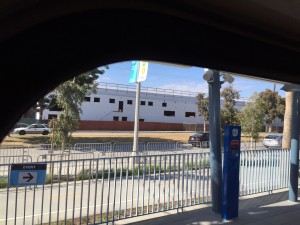As I feared, the travel time from downtown Los Angeles to downtown Santa Monica on the newly opened Expo rail line is worse-than-advertised, and the media is starting to notice. Joe Mathews has a very fair (and fairly depressing) account of his four-hour-plus commute from Pasadena to Santa Monica, worse than his typical three-hour commute by car:
The switch to the new Expo Line at the Metro Center station for the third leg of my trip was smooth. But the Expo Line was painfully slow. Metro had advertised a 48-minute ride, but it took more than an hour. The track runs down the middle of streets—and the train stops for traffic lights at some intersections. In Santa Monica, after a six-block walk, I arrived at work two and a half hours after I had reached the Pasadena station—25 miles away. In that same time, I could have flown to Las Vegas, played the airport slots, and flown home, jackpot in hand.
To be sure, the opening of the regional connector through downtown will certainly shave off travel time for riders like Joe. And if the City of Los Angeles can change the signal priority and street configuration, the trains will run a bit faster through downtown.
But otherwise, we’re left with a slow line, absent further infrastructure improvements like extra tracks to run express trains that can skip slow trains or more grade separation, like bridges over intersections. But those improvements cost money the region doesn’t have and won’t spend even if they had it, given how much Expo already cost to build and competing transit needs across the county.
So what’s the solution? The cheapest one is to shut down under-performing stations along the line. For anyone who’s ridden the line, it’s obvious there are some station areas that are low-rise and therefore low-ridership. Absent further development around them, Metro should shut them down and speed the ride for the majority of riders.
On the new extension, here are the initial ridership figures from one of the first days in service:
Palms: 1,016 TAP entries.
Westwood/Rancho Park: 661 TAP entries.
Expo/Sepulveda: 1,150 TAP entries.
Expo/Bundy: 1,376 TAP entries.
26th St/Bergamot: 853 TAP entries.
17th St/SMC: 1,020 TAP entries.
Downtown Santa Monica: 5,982 TAP entries.
If these trends continue, Metro should consider shutting down Westwood/Rancho Park and 26th Street/Bergamot on the new extension. (There would be particular irony in shutting down the 26th Street station, as local NIMBYs and their representatives on the city council prevented that station from becoming a thriving transit hub and instead relegated development to a suburban-style office park — see photo on the right of the building under construction).
Meanwhile, ridership data on the first phase of the extension to Culver City should inform which stations are shut down there. (Notably, one station on that phase was required as part of a legal settlement, which could complicate a shutdown effort for at least that station.)
The Expo Line runs 15.2 miles, and it shouldn’t take an hour. 15 miles per hour just isn’t providing much benefit over driving, if any. And it won’t make the line sustainable in the long run. So that’s why policy makers need to consider immediate action to improve the travel times.
One thought on “Time To Consider Shutting Down Underperforming Expo Line Stations”
-
Pingback: In Defense Of Shutting Down Underperforming Expo Line Stations | Ethan Elkind
Leave a Reply
You must be logged in to post a comment.



